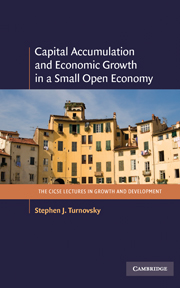Book contents
- Frontmatter
- Contents
- List of figures
- List of tables
- Preface
- 1 Introduction and brief overview
- PART ONE MODELS OF BALANCED GROWTH
- 2 Basic growth model with fixed labor supply
- 3 Basic growth model with endogenous labor supply
- PART TWO TRANSITIONAL DYNAMICS AND LONG-RUN GROWTH
- PART THREE FOREIGN AID, CAPITAL ACCUMULATION, AND ECONOMIC GROWTH
- References
- Index
3 - Basic growth model with endogenous labor supply
Published online by Cambridge University Press: 03 May 2010
- Frontmatter
- Contents
- List of figures
- List of tables
- Preface
- 1 Introduction and brief overview
- PART ONE MODELS OF BALANCED GROWTH
- 2 Basic growth model with fixed labor supply
- 3 Basic growth model with endogenous labor supply
- PART TWO TRANSITIONAL DYNAMICS AND LONG-RUN GROWTH
- PART THREE FOREIGN AID, CAPITAL ACCUMULATION, AND ECONOMIC GROWTH
- References
- Index
Summary
Introduction
The endogenous growth model analyzed in Chapter 2 includes two interdependent critical knife-edge restrictions: (i) inelastic labor supply, and (ii) fixed productivity of capital. The structure of the equilibrium changes fundamentally when the labor supply is endogenized. This introduces two key changes. The first is that the production function is modified to (2.8), so that the productivity of capital now depends positively upon the fraction of time devoted to productive labor. Second, the fixed endowment of a unit of time leads to the requirement that the steady-state allocation of time between labor and leisure must be constant. This latter condition provides a link between the long-run rate of growth of consumption and the rate of growth of output, forcing them to grow at the same constant rate.
In this chapter we address the role of an elastic supply of labor in some depth, focusing particularly on the effectiveness of fiscal policy in such an economy. As in a closed economy, endogenizing labor supply leads to important changes in the equilibrium structure of the economy, and has important implications for fiscal policy. But in contrast to the closed economy, the introduction of an elastic labor supply yields a less, rather than a more, potent role for distortionary taxes in influencing the equilibrium growth rate. Not only do the taxes on wage income and consumption continue to have very limited effects, but now, in addition, the capital income tax ceases to have any effect on the growth rate of output and capital.
- Type
- Chapter
- Information
- Publisher: Cambridge University PressPrint publication year: 2009

